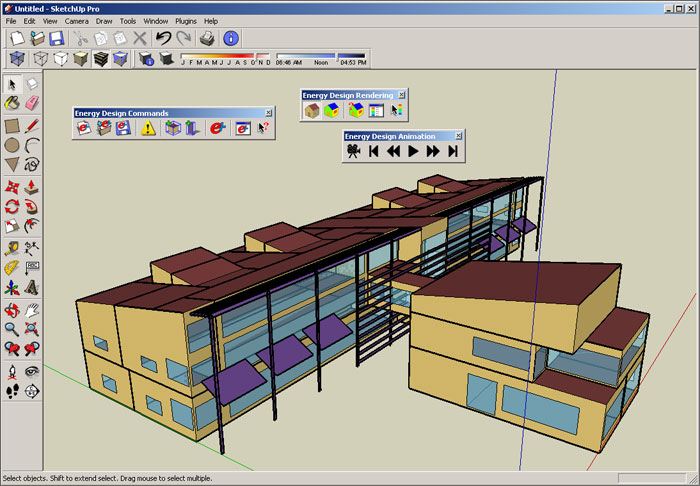This article is part of BD+C's special five-part Technology Report 2014: Top tech tools and trends for AEC professionals.
For more than a decade, the U.S. Department of Energy has made its EnergyPlus energy analysis and thermal load simulation program available for free to Building Teams.
Using EnergyPlus, AEC professionals can model heating, cooling, lighting, ventilation, and other energy flows, as well as water consumption, within a building design.
But without a major rewrite of the program since its creation, using EnergyPlus could exhibit slow performance and occasionally inaccurate analysis results.
The programming language it was originally written in, Fortran, simply could not keep up with advances in the hardware and software computing environment. FORTRAN is a language aimed at scientific programs to be run by scientists for days and weeks on supercomputers, not by building designers running multiple iterations of a design idea in a matter of a few hours.
Because it wasn't well integrated with common architectural design software, EnergyPlus never gained widespread adoption by architects working in the conceptual stage of a project.
At Greenbuild 2013, Autodesk (working pro bono) turned over brand new engine source code to the DOE to create a completely rewritten EnergyPlus for a forthcoming version. The new code will be made available under the DOE’s open source license.
Autodesk’s software engineers translated EnergyPlus—more than 600,000 lines of code—to C++, a modern, object-oriented language that is better supported on mass-market hardware and software platforms.
As a result, a larger ecosystem of developers and vendors will be able to contribute updates to the code in order to improve performance and decrease the time required to run energy model simulations.
The forthcoming version will also work better with BIM applications, auditing tools, and energy dashboards after it is released and developers are able to work on improved integrations.
For more, visit: http://apps1.eere.energy.gov/buildings/energyplus.
Related Stories
Sustainability | Sep 18, 2024
3 living buildings made by a living practice
Prompting humans to reexamine our relationship to the environment, architecture creates the opportunity for us to physically experience ideas of beauty, performance, and structure through the distinct lens of place.
3D Printing | Sep 17, 2024
Alquist 3D and Walmart complete one of the nation’s largest free-standing, 3D-printed commercial structures
Walmart has completed one of the largest free-standing, 3D-printed commercial structures in the US. Alquist 3D printed the almost 8,000-sf, 20-foot-high addition to a Walmart store in Athens, Tenn. The expansion, which will be used for online pickup and delivery, is the first time Walmart has applied 3D printing technology at this scale.
Retail Centers | Sep 17, 2024
Thinking outside the big box (store)
For over a decade now, the talk of the mall industry has been largely focused on what developers can do to fill the voids left by a steady number of big box store closures. But what do you do when big box tenants stay put?
Government Buildings | Sep 17, 2024
OSHA’s proposed heat standard published in Federal Register
The Occupational Safety and Health Administration (OSHA) has published a proposed standard addressing heat illness in outdoor and indoor settings in the Federal Register. The proposed rule would require employers to evaluate workplaces and implement controls to mitigate exposure to heat through engineering and administrative controls, training, effective communication, and other measures.
Codes and Standards | Sep 17, 2024
New California building code encourages, but does not mandate heat pumps
New California homes are more likely to have all-electric appliances starting in 2026 after the state’s energy regulators approved new state building standards. The new building code will encourage installation of heat pumps without actually banning gas heating.
Mass Timber | Sep 17, 2024
Marina del Rey mixed-use development is L.A.’s largest mass timber project
An office-retail project in Marina del Rey is Los Angeles’ largest mass timber project to date. Encompassing about 3 acres, the 42XX campus consists of three low-rise buildings that seamlessly connect with exterior walkways and stairways. The development provides 151,000 sf of office space and 1,500 sf of retail space.
Education Facilities | Sep 16, 2024
Hot classrooms, playgrounds spur K-12 school districts to go beyond AC for cooling
With hotter weather occurring during the school year, school districts are turning to cooling strategies to complement air conditioning. Reflective playgrounds and roads, cool roofs and window films, shade structures and conversion of asphalt surfaces to a natural state are all being tried in various regions of the country.
Office Buildings | Sep 16, 2024
Maximizing office square footage through ‘agile planning’
Lauren Elliott, RID, NCIDQ, Director of Interior Design, Design Collaborative, shares tips for a designing with a popular and flexible workspace model: Agile planning.
3D Printing | Sep 13, 2024
Swiss researchers develop robotic additive manufacturing method that uses earth-based materials—and not cement
Researchers at ETH Zurich, a university in Switzerland, have developed a new robotic additive manufacturing method to help make the construction industry more sustainable. Unlike concrete 3D printing, the process does not require cement.
Libraries | Sep 12, 2024
How space supports programming changes at university libraries
GBBN Associate Sarah Kusuma Rubritz, AIA, uses the University of Pittsburgh's Hillman Library to showcase how libraries are transforming to support students’ needs.

















